ECS, ECR, Fargate
Docker Containers Management on AWS
- Amazon Elastic Container Service (Amazon ECS)
- Amazon’s own container platform
- Amazon Elastic Kubernetes Service (Amazon EKS)
- Amazon’s managed Kubernetes (open source)
- AWS Fargate
- Amazon’s own Serverless container platform
- Works with ECS and with EKS
- Amazon ECR
- Store container images
Amazon ECS
EC2 Launch Type
- ECS = Elastic Container Service
- Launch Docker containers on AWS = Launch ECS Tasks on ECS Clusters
- EC2 Launch Type: you must provision & maintain the infrastructure (the EC2 instances)
- Each EC2 Instance must run the ECS Agent to register in the ECS Cluster
- AWS takes care of starting / stopping containers
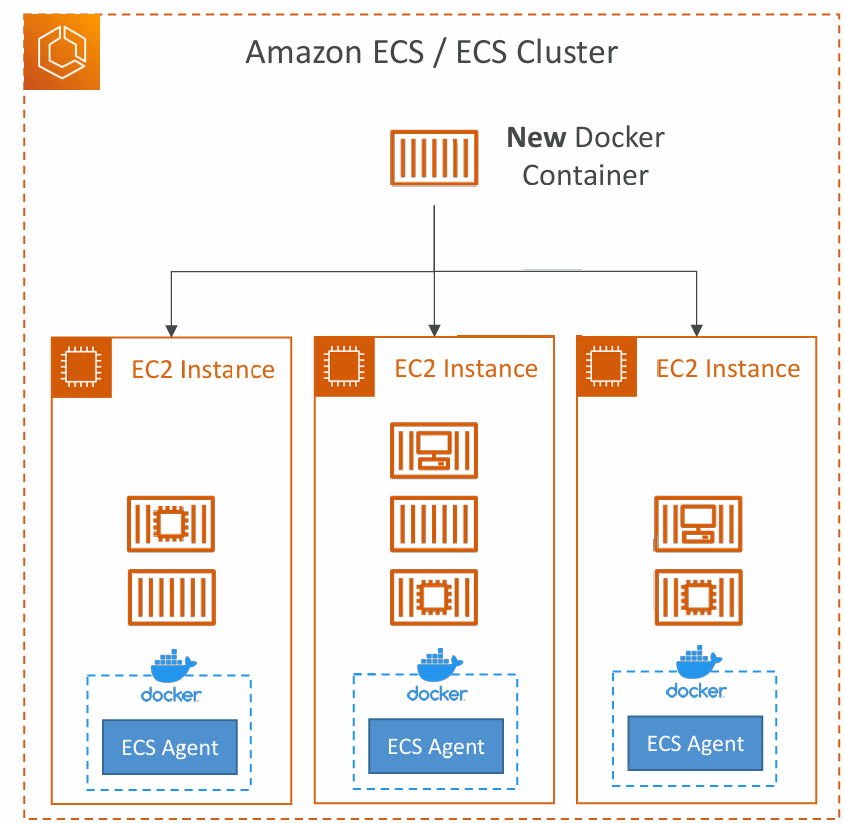
Fargate Launch Type
- Launch Docker containers on AWS
- You do not provision the infrastructure (no EC2 instances to manage)
- It’s all Serverless!
- You just create task definitions
- AWS just runs ECS Tasks for you based on the CPU / RAM you need
- To scale, just increase the number of tasks. Simple - no more EC2 instances
IAM Roles for ECS
EC2 Instance Profile (EC2 Launch Type only)
- Used by the ECS agent
- Makes API calls to ECS service
- Send container logs to CloudWatch Logs
- Pull Docker image from ECR
- Reference sensitive data in Secrets Manager or SSM Parameter Store
ECS Task Role
- Allows each task to have a specific role
- Use different roles for the different ECS Services you run
- Task Role is defined in the task definition
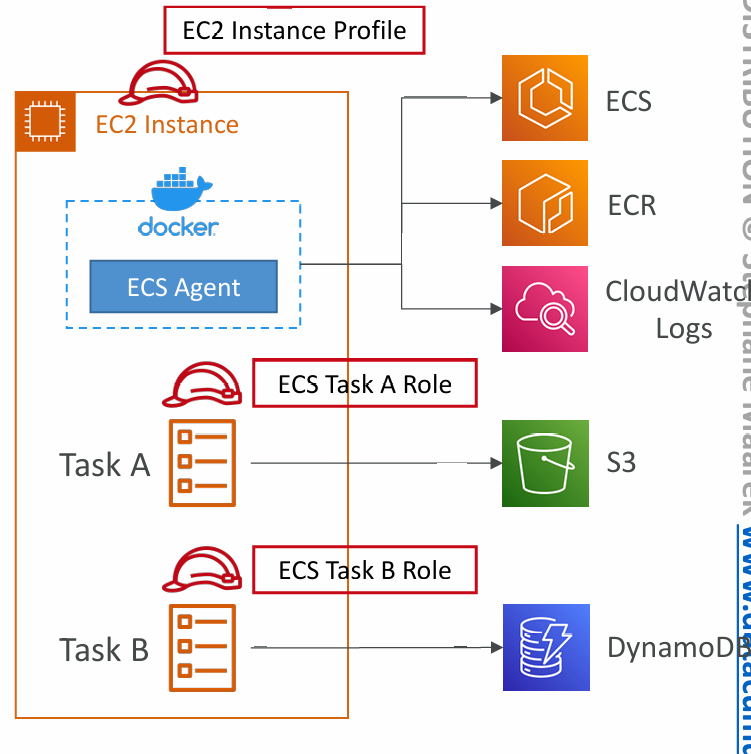
Load Balancer Integrations
- Application Load Balancer supported and works for most use cases
- Network Load Balancer recommended only for high throughput / high performance use cases, or to pair it with AWS Private Link
- Classic Load Balancer supported but not recommended (no advanced features – no Fargate)
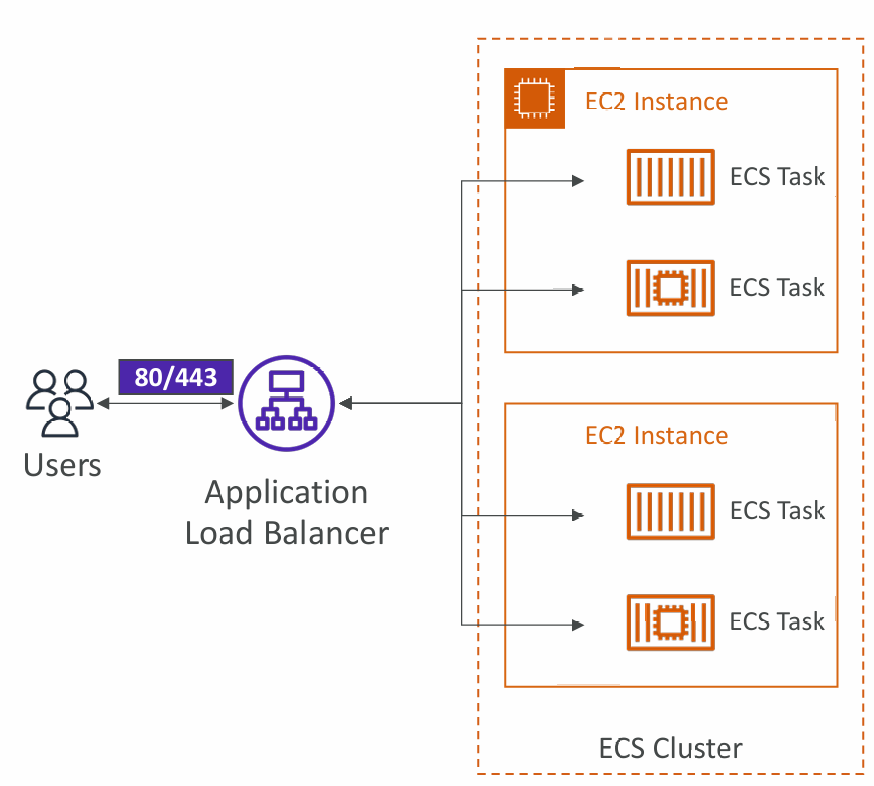
Data Volumes (EFS)
- Mount EFS file systems onto ECS tasks
- Works for both EC2 and Fargate launch types
- Tasks running in any AZ will share the same data in the EFS file system
- Fargate + EFS = Serverless
- Use cases: persistent multi-AZ shared storage for your containers
- Note: Amazon S3 cannot be mounted as a file system
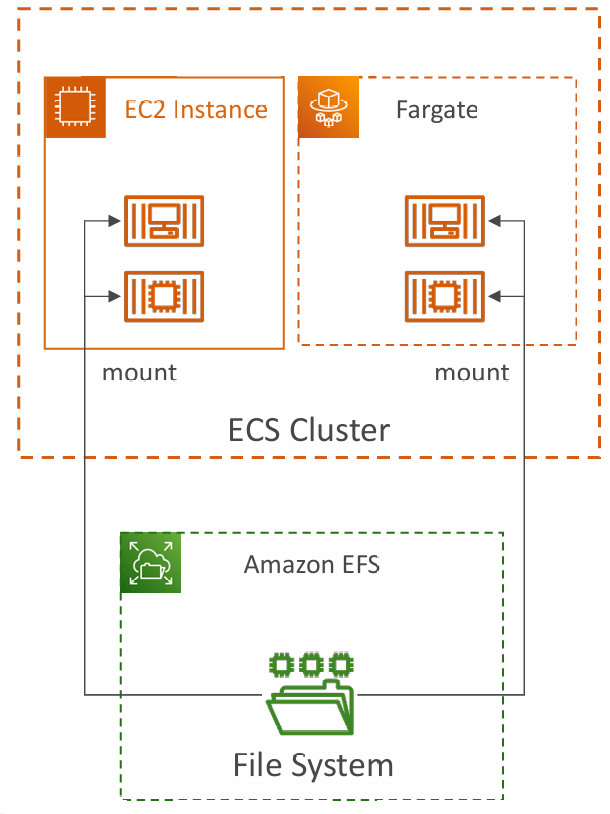
Auto Scaling
- Automatically increase/decrease the desired number of ECS tasks
- Amazon ECS Auto Scaling uses AWS Application Auto Scaling
- ECS Service Average CPU Utilization
- ECS Service Average Memory Utilization - Scale on RAM
- ALB Request Count Per Target – metric coming from the ALB
- Target Tracking – scale based on target value for a specific CloudWatch metric
- Step Scaling – scale based on a specified CloudWatch Alarm
- Scheduled Scaling – scale based on a specified date/time (predictable changes)
- ECS Service Auto Scaling (task level) ≠ EC2 Auto Scaling (EC2 instance level)
- Fargate Auto Scaling is much easier to setup (because Serverless)
Launch Type – Auto Scaling EC2 Instances
- Accommodate ECS Service Scaling by adding underlying EC2 Instances
- Auto Scaling Group Scaling
- Scale your ASG based on CPU Utilization
- Add EC2 instances over time
- ECS Cluster Capacity Provider
- Used to automatically provision and scale the infrastructure for your ECS Tasks
- Capacity Provider paired with an Auto Scaling Group
- Add EC2 Instances when you’re missing capacity (CPU, RAM…)
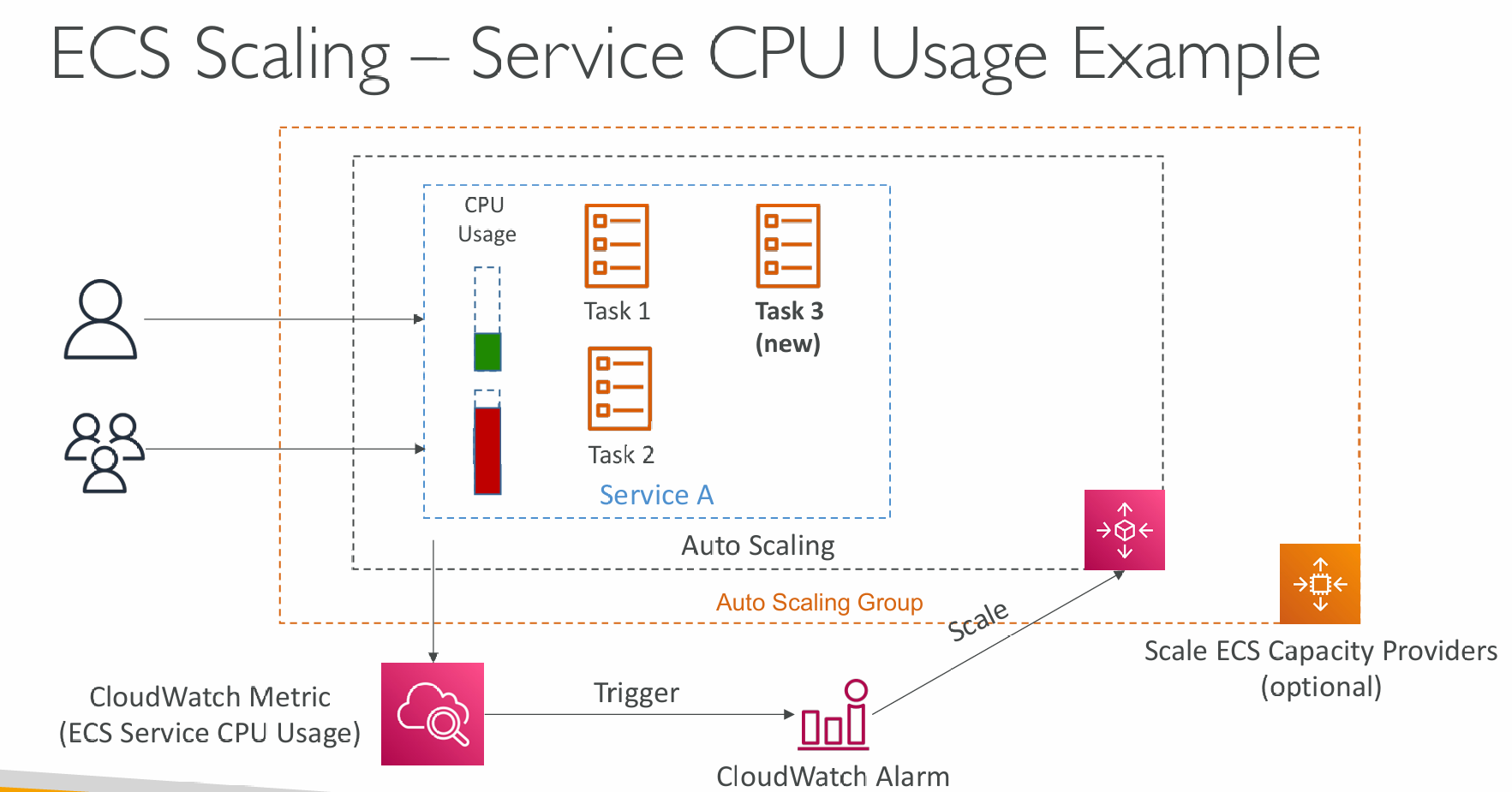
ECS Rolling Updates
When updating from v1 to v2, we can control:
- how many tasks can be started and stopped
- and in which order
- done by giving minimum and maximum healthy services percentage
ECS tasks invoked by Event Bridge
- Tasks can be invoked through an event
- Can also be done on a schedule instead of on an action (e.g. every hour)
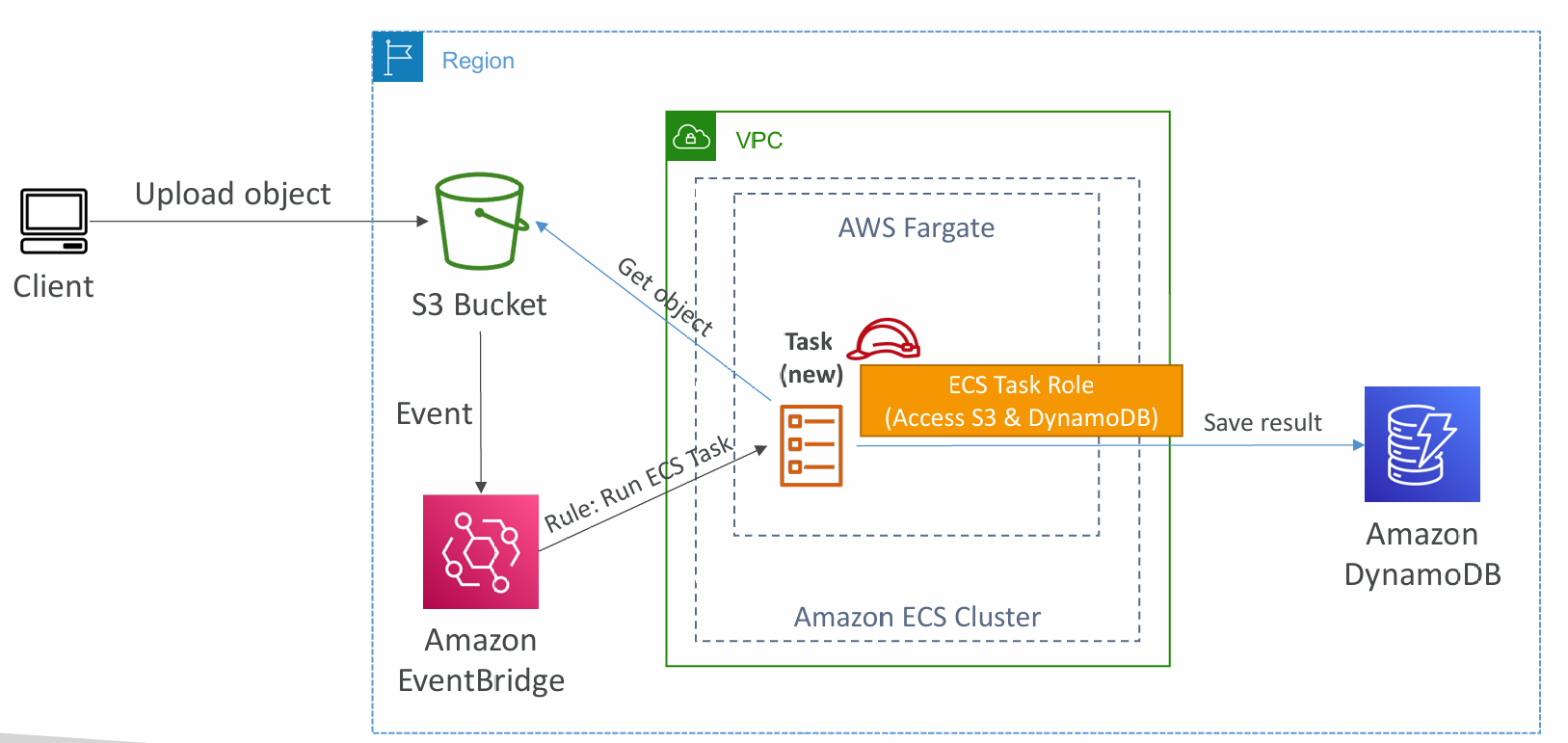
Intercept Stopped Tasks using EventBridge
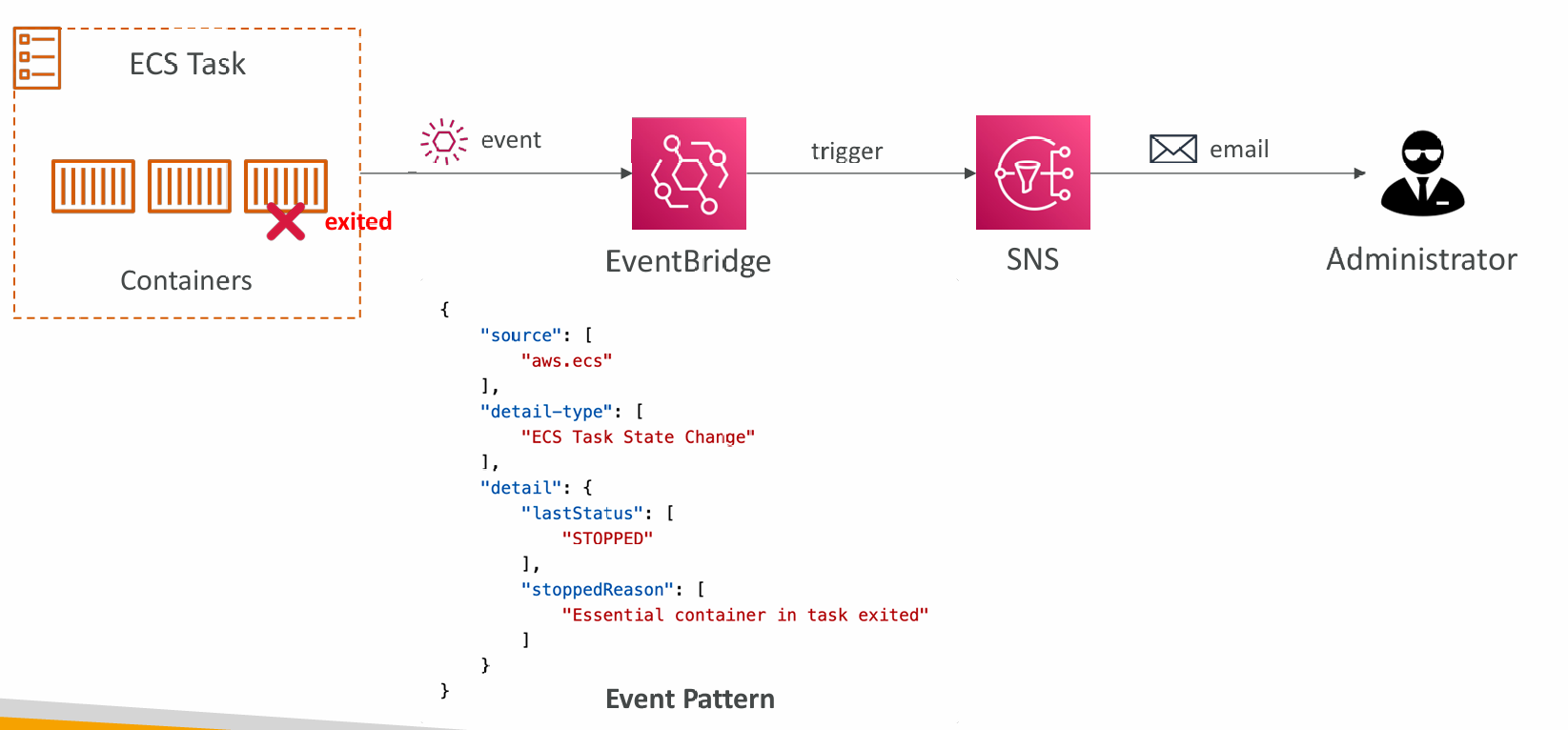
Task Definitions
- Task definitions are metadata in JSON form to tell ECS how to run a Docker container
- It contains crucial information, such as:
- Image Name
- Port Binding for Container and Host
- Memory and CPU required
- Environment variables
- Networking information
- IAM Role
- Logging configuration (ex CloudWatch)
- Can define up to 10 containers in a Task Definition
Load Balancing
EC2 Launch Type
- We get a Dynamic Host Port Mapping if you define only the container port in the task definition
- The ALB finds the right port on your EC2 Instances
- You must allow on the EC2 instance’s Security Group any port from the ALB’s Security Group
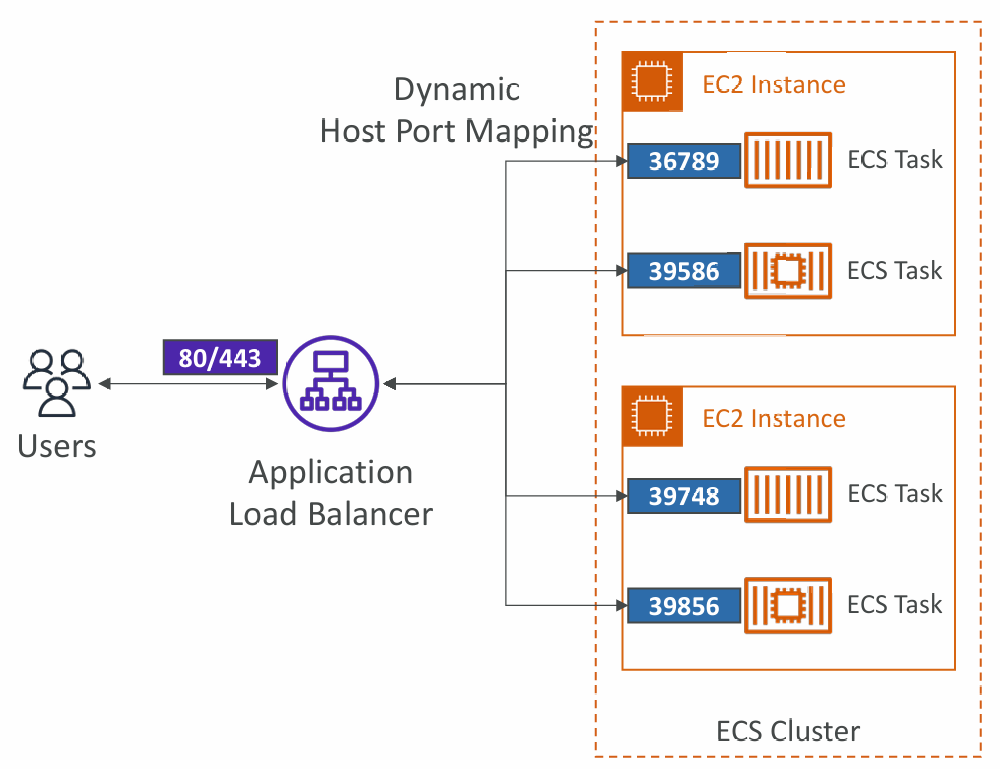
Fargate
- Each tas has a unique private IP
- Only define the container port (host port is not applicable)
- Example
- ECS ENI Security Group
- Allow port 80 from the ALB
- ALB Security Group
- Allow port 80/443 from web
- ECS ENI Security Group
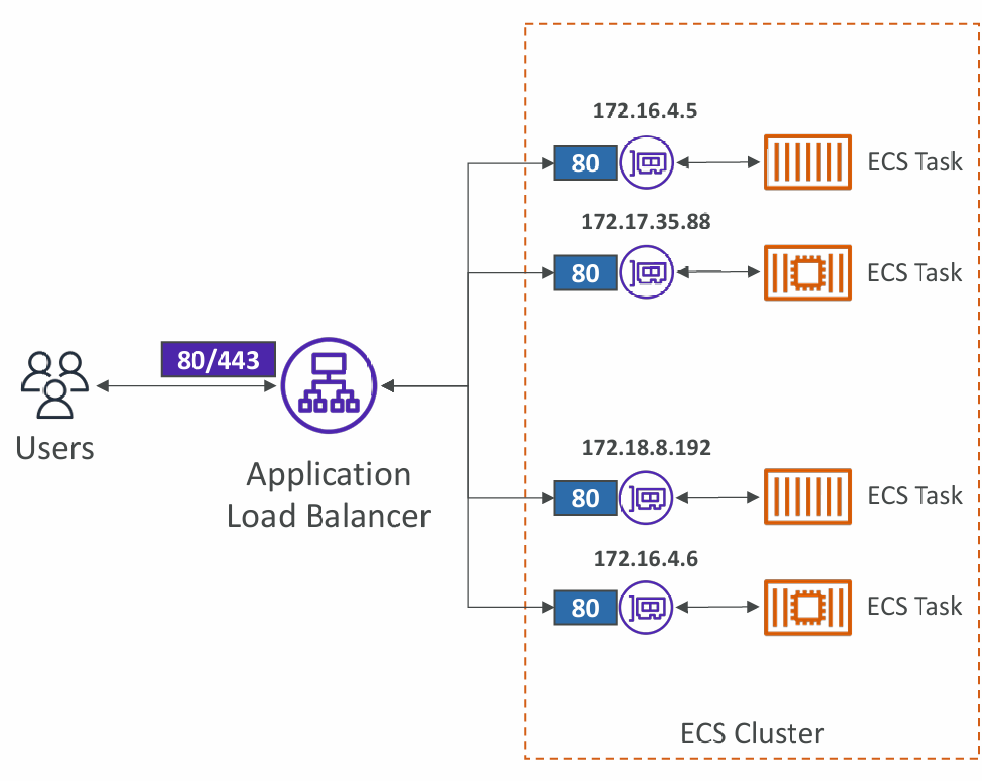
One IAM Role per Task Definition
- Each task definition can take a task role
- The task role can control the access to resources
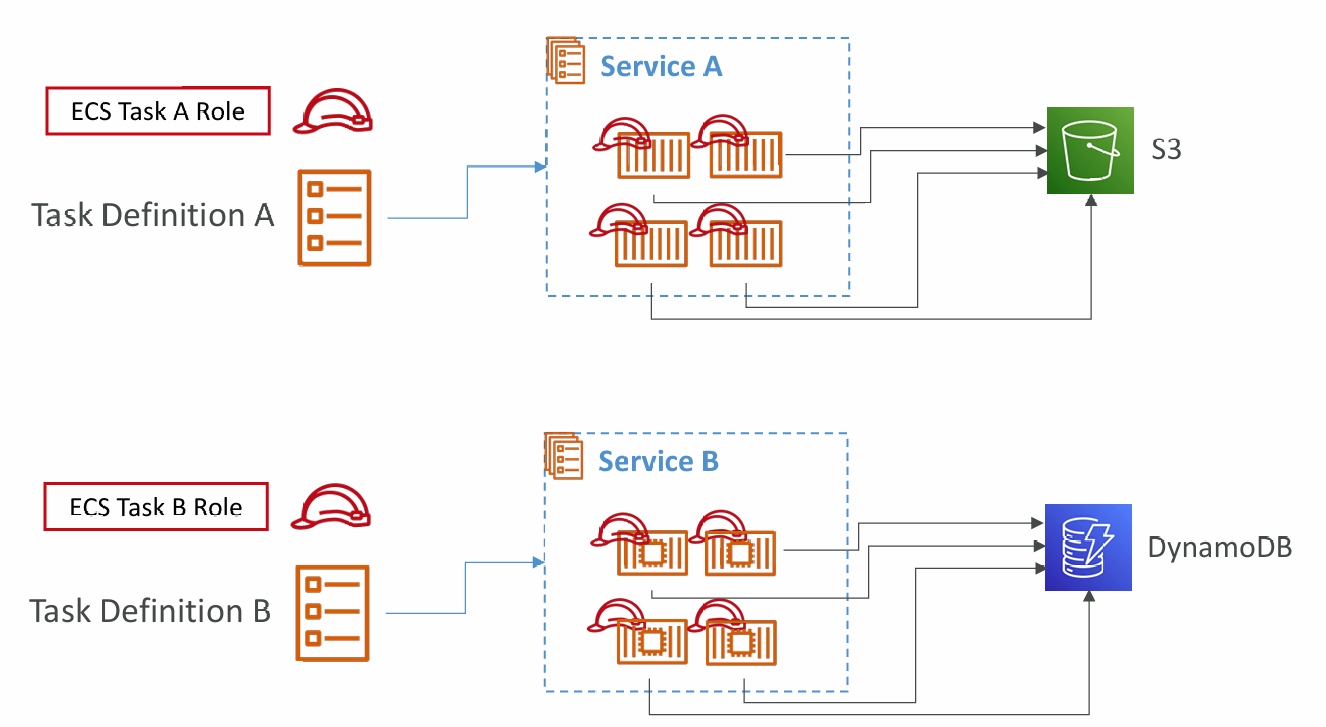
Environment Variables
- Environment Variable
- Hardcoded – e.g., URLs
- SSM Parameter Store – sensitive variables (e.g., API keys, shared configs)
- Secrets Manager – sensitive variables (e.g., DB passwords)
- Environment Files (bulk) – Amazon S3
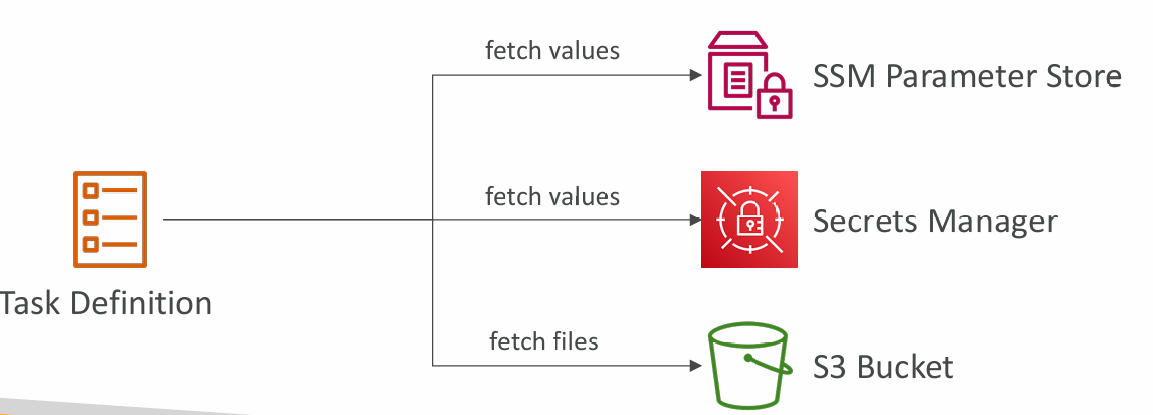
Data Volumes (Bind Mounts)
- Share data between multiple containers in the same Task Definition
- Works for both EC2 and Fargate tasks
- EC2 Tasks – using EC2 instance storage
- Data are tied to the lifecycle of the EC2 instance
- Fargate Tasks – using ephemeral storage
- Data are tied to the container(s) using them
- 20 GiB – 200 GiB (default 20 GiB)
- Use cases:
- Share ephemeral data between multiple containers
- “Sidecar” container pattern, where the “sidecar” container used to send metrics/logs to other destinations (separation of conerns)
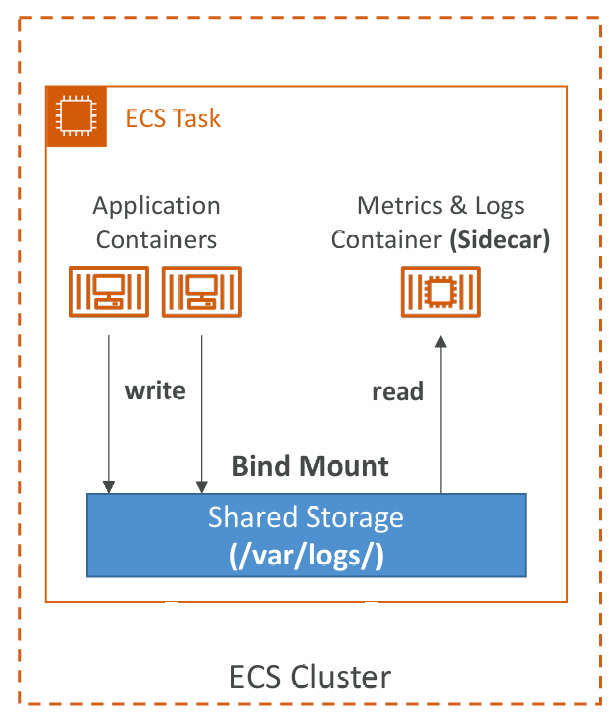
Task Placement
- When an ECS task is started with EC2 Launch Type, ECS must determine where to place it, with the constraints of CPU and memory (RAM)
- Similarly, when a service scales in, ECS needs to determine which task to terminate
- You can define:
- Task Placement Strategy
- Task Placement Constraints
- Note: only for ECS Tasks with EC2 Launch Type (Fargate not supported)
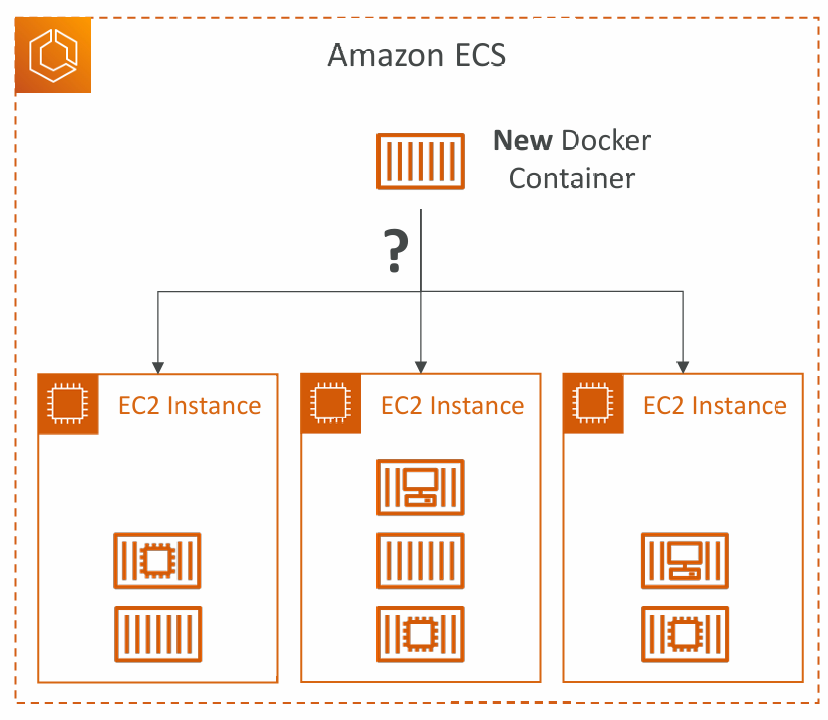
- Task Placement Strategies are a best effort
- When Amazon ECS places a task, it uses the following process to select the appropriate EC2 Container instance:
- Identify which instances that satisfy the CPU, memory, and port requirements
- Identify which instances that satisfy the Task Placement Constraints
- Identify which instances that satisfy the Task Placement Strategies
- Select the instances
Binpack
- Tasks are placed on the least available amount of CPU and Memory
- Minimizes the number of EC2 instances in use (cost savings)
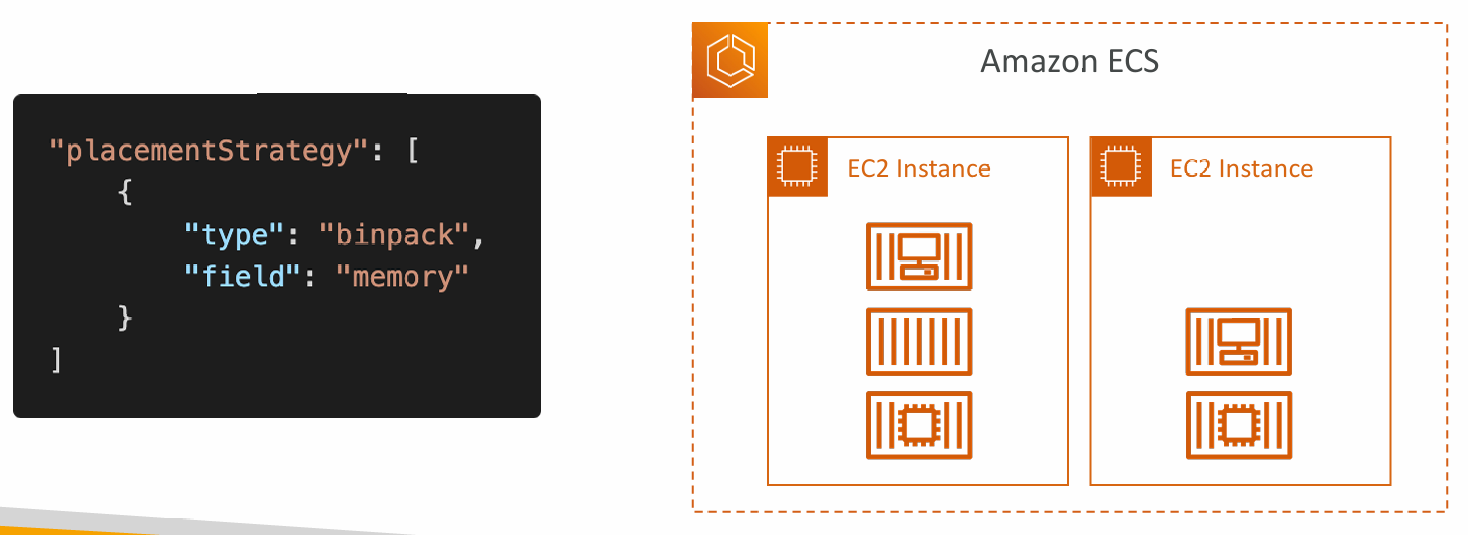
Random
- Tasks are placed randomly
Spread
- Tasks are placed evenly based on the specified value
- Example: instanceId, attribute:ecs.availability-zone, …

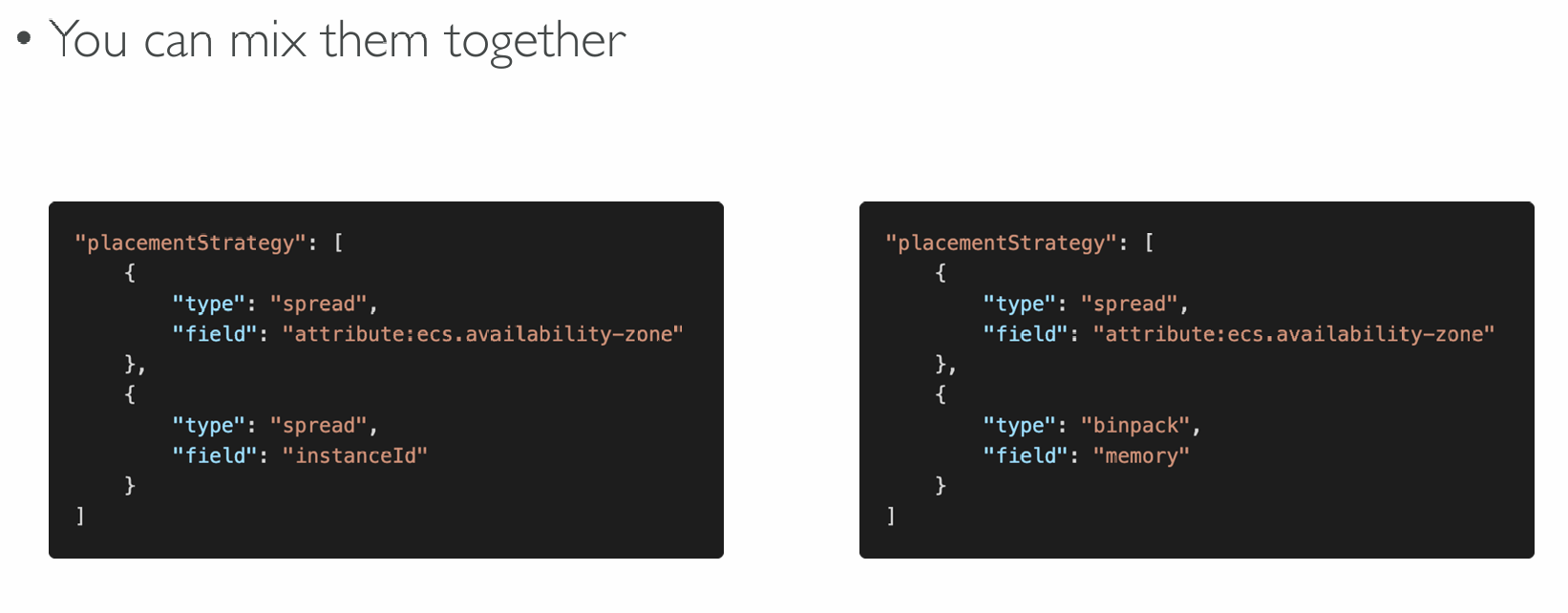
Task Placement Constraints
- distinctInstance
- Tasks are placed on a different EC2 instance
- memberOf
- Tasks are placed on EC2 instances that satisfy a specified expression
- Uses the Cluster Query Language (advanced)

Amazon ECR
- ECR = Elastic Container Registry
- Store and manage Docker images on AWS
- Private and Public repository (Amazon ECR Public Gallery https://gallery.ecr.aws)
- Fully integrated with ECS, backed by Amazon S3 Access is controlled through IAM (permission errors => policy)
- Supports image vulnerability scanning, versioning, image tags, image lifecycle, …
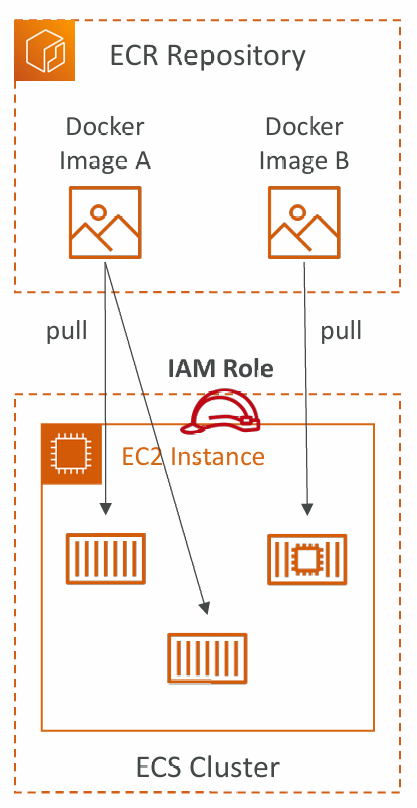
Using AWS CLI
- Login Command
- aws ecr get-login-password --region region | docker login --username AWS--password-stdin aws_account_id.dkr.ecr.region.amazonaws.com
- Docker Commands
- docker push aws_account_id.dkr.ecr.region.amazonaws.com/demo:latest
- docker pull aws_account_id.dkr.ecr.region.amazonaws.com/demo:latest
- In case an EC2 instance (or you) can’t pull a Docker image, check IAM permissions
AWS Copilot
- CLI tool to build, release, and operate production-ready containerized apps
- Run your apps on AppRunner, ECS, and Fargate
- Helps you focus on building apps rather than setting up infrastructure
- Provisions all required infrastructure for containerized apps (ECS, VPC, ELB, ECR…)
- Automated deployments with one command using CodePipeline
- Deploy to multiple environments
- Troubleshooting, logs, health status…

Amazon EKS Overview
- Amazon EKS = Amazon Elastic Kubernetes Service
- It is a way to launch managed Kubernetes clusters on AWS
- Kubernetes is an open-source system for automatic deployment, scaling and management of containerized (usually Docker) application
- It’s an alternative to ECS, similar goal but different API
- EKS supports EC2 if you want to deploy worker nodes or Fargate to deploy serverless containers
- Use case: if your company is already using Kubernetes on-premises or in another cloud, and wants to migrate to AWS using Kubernetes
- Kubernetes is cloud-agnostic (can be used in any cloud – Azure, GCP…)
- For multiple regions, deploy one EKS cluster per region
- Collect logs and metrics using CloudWatch Container Insights
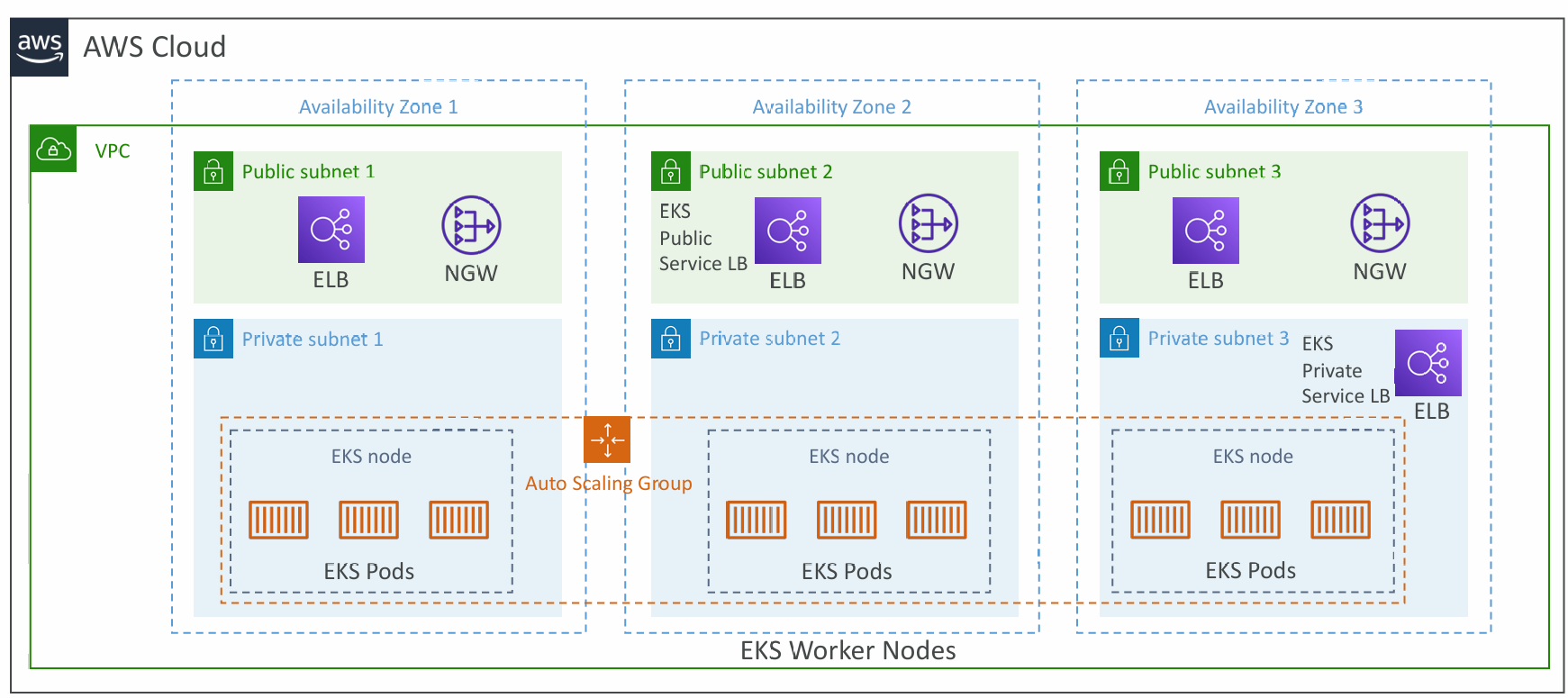
Node Types
- Managed Node Groups
- Creates and manages Nodes (EC2 instances) for you
- Nodes are part of an ASG managed by EKS
- Supports On-Demand or Spot Instances
- Self-Managed Nodes
- Nodes created by you and registered to the EKS cluster and managed by an ASG
- You can use prebuilt AMI - Amazon EKS Optimized AMI
- Supports On-Demand or Spot Instances
- AWS Fargate
- No maintenance required; no nodes managed
Data Volumes
- Need to specify StorageClass manifest on your EKS cluster
- Leverages a Container Storage Interface (CSI) compliant driver
- Support for…
- Amazon EBS
- Amazon EFS (works with Fargate)
- Amazon FSx for Lustre
- Amazon FSx for NetApp ONTAP